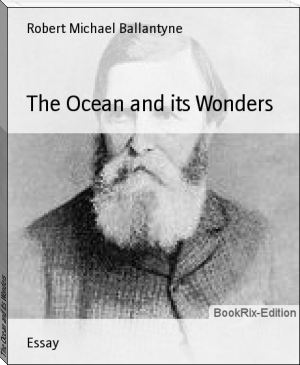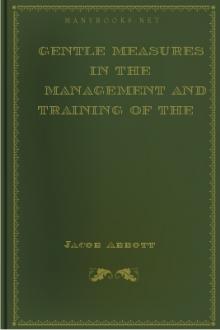The Ocean and its Wonders by Robert Michael Ballantyne (most recommended books .TXT) 📖

- Author: Robert Michael Ballantyne
Book online «The Ocean and its Wonders by Robert Michael Ballantyne (most recommended books .TXT) 📖». Author Robert Michael Ballantyne
Here, then, in all probability, is the great Arctic Ocean that has been supposed to exist in a perpetually fluid state round the pole, encircled by a ring of ice that has hitherto presented an impenetrable barrier to all the adventurers of ancient and modern times. There were several facts connected with this discovery that go far to prove that this ocean is perpetually open.
Further south, where Dr Kane's brig lay in ice that seemed never to melt, there were few signs of animal life--only a seal or two now and then; but here, on the margin of this far northern sea, were myriads of water-fowl of various kinds.
"The Brent goose," writes the Doctor, "had not been seen before since entering Smith's Strait. It is well known to the polar traveller as a migratory bird of the American continent. Like the others of the same family, it feeds upon vegetable matter, generally on marine plants, with their adherent molluscan life. It is rarely or never seen in the interior; and from its habits may be regarded as singularly indicative of open water. The flocks of this bird, easily distinguished by their wedge-shaped line of flight, now crossed the water obliquely, and disappeared over the land to the north-east.
"The rocks on shore were crowded with sea-swallows, birds whose habits require open water; and they were already breeding. The gulls were represented by no less than four species. The kittiwakes--reminding Morton of `old times in Baffin's Bay'--were again stealing fish from the water (probably the small whiting), and their grim cousins, the burgomasters, enjoying the dinner thus provided at so little cost to themselves. It was a picture of life all round.
"Here, for the first time, Morton noticed the arctic petrel,--a fact which shows the accuracy of his observation, though he had not been aware of its importance. This bird had not been met with since we left the north water of the English whalers, more than two hundred miles south of the position on which he stood. Its food is essentially marine; and it is seldom seen in numbers, except in the highways of open water frequented by the whale and the larger representatives of ocean life. They were in numbers flitting and hovering over the crests of the waves, like their relatives of kinder climates,--the Cape of Good Hope pigeons, Mother Carey's chickens, and the petrels everywhere else.
"It must have been an imposing sight, as Morton stood at this termination of his journey, looking out upon the great waste of waters before him. Not a speck of ice could be seen. There, from a height of 480 feet, which commanded a horizon of almost forty miles, his ears were gladdened with the novel music of dashing waves; and a surf, breaking in among the rocks at his feet, stayed his further progress."
Strong presumptive evidence, all this, that there is an ocean of open water round the pole, and a milder climate there than exists nearer to the arctic circle. Had the short barrier of ice that intervened between the brig and that mysterious sea been removed, as, perchance, it is sometimes removed by a hot summer, Dr Kane might have been the first to reach the North Pole. This, however, is reserved for some other navigator. The gallant Kane now lies in an early grave but some of his enterprising comrades have returned to those regions, bent on solving this problem; and it is possible that, even while we now write, their adventurous keel may be ploughing the waters of the hitherto untraversed and mysterious polar sea.
CHAPTER THIRTEEN.
MISCELLANEOUS PHENOMENA OF THE POLAR SEAS AND REGIONS--THE AURORA BOREALIS--ICE-BLINK--OPTICAL ILLUSIONS--ANECDOTE OF SCORESBY--HALOES-- CORONAE--MOCK SUNS--REFRACTION--FROSTS.
Owing to the intensity of the cold in the arctic regions, there are, as we may readily believe, many singular appearances connected with the ocean and the atmosphere, which are worthy of special notice.
Chief, perhaps, among the phenomena of those regions is the _Aurora Borealis_.
Ever mindful of the welfare of the creatures whom he has formed, the Almighty has appointed a light to mitigate the darkness of the polar regions when the sun, in its appointed course, withdraws for a season.
What the aurora borealis is no one knows, although many have hazarded opinions regarding it.
What it is like is known even to ourselves, though the faint indications of it which sometimes seen in our own heavens are not to be compared to the brilliancy of the spectacle that is occasionally presented in the northern skies.
The most ordinary aspect of the aurora is that of a band of pale-green light extending irregularly over part of the sky, and marked by wavy motions, as well as by varying brightness. Sometimes one part of this band becomes more bright than another part. Sometimes the whole seems to move gently, like the undulations of a flag in a light breeze; at other times more vigorous action takes place, and pointed tongues of light shoot vividly up into the zenith. This sometimes takes place so frequently, and the tongues are so long and numerous, that the aurora has been popularly termed the "northern streamers."
Although pale-green is the most frequent colour, the aurora borealis has often been observed with blue and red hues; and the sky has been seen suffused with an intense crimson colour by it.
Captains Parry and Lyon saw these northern lights in full splendour during their residence in the arctic regions. They tell us that "the aurora had a tendency to form an irregular arch, which, in calm weather, was very often distinct, though its upper boundary was seldom well defined; but whenever the air was agitated, showers of rays spread in every direction with the rapidity of lightning, but always appearing to move to and from a fixed point, somewhat like a ribbon held in the hand and shaken with an undulatory motion. No rule, however, could be traced in the movement of those lighter parcels called the `merry dancers,' which flew about perpetually towards every quarter; becoming in stormy weather more rapid in their motions, and sharing all the wildness of the blast. They gave an indescribable air of magic to the whole scene, and made it not wonderful that, by the untaught Indian, they should be viewed as `the spirits of his fathers roaming through the land of souls.'"
We are told by some that the aurora borealis is accompanied by a loud hissing and crackling sound and Captain Lyon says that the sudden glare and rapid bursts of those wondrous showers of fire make it difficult to believe that their movements are wholly without sound. Yet such would seem to be the case, for the same authority tells us that he stood on the ice for hours listening intently and could hear nothing. He was thoroughly convinced that no sound proceeds from the aurora, and most intelligent voyagers support him in this opinion.
That the aurora dims the lustre of the stars seen through it, is a fact which was ascertained clearly by the same gentleman; and that it moves in a region beyond the clouds is also evident from the fact that when the latter covered the sky the aurora disappeared.
But some of the most singular appearances of the sea and sky in the polar regions are presented in summer. During that season the perpetual presence of the sun and the large tracts of ice floating about on the sea exert their opposing influences so as to produce the most astonishing results.
One part of the sea being covered with ice, produces a cold atmosphere; another part being free from ice, produces a warmer atmosphere. Refraction is the result of viewing objects through those different media, and very curious appearances follow. When Scoresby was in Greenland a singular atmospheric phenomenon occurred, whereby he became aware of the approach of his father's ship some time before it rose above the horizon. He had reached Greenland before his father, who followed him in the _Fame_. The following is his account of the circumstance:
"On my return to the ship, about eleven o'clock, the night was beautifully fine and the air quite mild. The atmosphere, in consequence of the warmth, being in a highly refractive state, a great many curious appearances were presented by the land and icebergs. The most extraordinary effect of this state of the atmosphere, however, was the distinct inverted image of a ship in the clear sky, over the middle of the large bay or inlet, the ship itself being entirely beyond the horizon. Appearances of this kind I have before noticed, but the peculiarities of this were the perfection of the image, and the great distance of the vessel that it represented. It was so extremely well defined, that, when examined with a telescope, I could distinguish every sail, the general `rig of the ship,' and its peculiar character; insomuch that I confidently pronounced it to be my father's ship the _Fame_, which it afterwards proved to be, though, on comparing notes with my father, I found that our relative positions at the time gave our distance from one another very nearly thirty miles, being about seventeen miles beyond the horizon, and some leagues beyond the line of direct vision."
Scoresby was, perhaps, one of the most persevering and intelligent observers of nature that ever went to the polar seas. His various accounts of what he saw are most interesting. We cannot do better than quote his remarks upon _ice-blink_, that curious appearance of white light on the horizon, whereby voyagers are led to infer the presence of ice:--
"This appearance of the _ice-blink_," says he, "occurred on the 13th of June 1820, in latitude 76 degrees north. The sky aloft was covered with dense, uniform, hazy cloud, which indeed occupied the whole of the heavens, excepting a portion near the horizon, where it seemed to be repelled. The upper white blink referred to ice about six miles distant, being beyond the horizon; the narrow yellowish portions referred to floes and compact ice; the lowest yellow blink, which in brightness and colour resembled the moon, was the reflection of a field at the distance of thirty miles, to which, directed by the blink, we made way in the _Baffin_, through the channels of water represented in the sky by bluish-grey streaks. The field we found to be a sheet of ice 150 miles in circumference!"
Another very singular appearance observed occasionally in foggy weather is a series of bright circles, or coronae, surrounding the heads or persons of individuals in certain positions. We have, while standing at the mast-head of a vessel in Hudson's Straits, observed our own shadow thrown on the sea with a bright halo round it. The day was bright and hazy at the time. Referring to a particular case of this kind, Scoresby says:
"During the month of July 1820, the weather being often foggy, with a bright sun sometimes shining at the height of the day, some extraordinary coronae were observed from the mast-head. These





Comments (0)